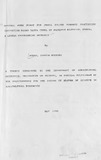Optimal, farm plans for small holder farmers practising irrigation along Yatta canal of Machakos District, Kenya: a linear programming approach
Abstract
The main objective of the study was to develop optimal
farm plans for irrigation farmers along the Yatta canal who
are permitted to irrigate a maXlmum area of 0.5 hectare per
growing season. Other objectives of the study were:
1) to describe the existing farming system in the study area
2) to identify the main constraints faced by the irrigation
farmers along the Yatta canal.
A random sample of 60 farmers was used in this study.
Optimal farm plans were developed using linear programming
farm planning technique and are meant to guide the farmers in
their farming activities to ensure maximization of farm
income. This would mean that maximum benefits are gained from
the irrigation water.
The study tested the hypothesis that the present level
of resource use is sub-optimal and hence higher farm income
could be realized by reorganizing the existing crop
enterprises. Total gross margin comparisons of the developed
optimal farm plans and the existing farming system are used
to test the hypothesis. When the comparisons considered the
existing farming system which is based on an average farm,
net increments in total gross margin resulting from the
optimal farm plans were found to range between 27.6 percent
and 120.6 percent. Similar comparisons made under the
assumption that the available irrigable land is fully
utilized in the existing farming system had net increments
ranging between 7.5 percent and 30.8 percent. Based on this findings the hypothesis was accepted.
Working capital was found to be a limiting resource in
all the farm models considered . Results of the study showed
that the marginal value product for capital ranged between
Kshs. 1.483 and Kshs. 12.70. Such findings imply that the
increment s to every additional Kenya shilling of working
capital invested in the optimal farm plans are higher than
the current lendingg rate of 14% charged by lending
institutions for agricultiral loans. Assuming other factors
constant, it is therefore economically feasible to obtain
credit from the lending institutions.
Both irrigated and unirrigated land were found to be
limiting resources in most of the farm plans. Comparatively
irrigated land had higher shadow prices than the unirrigated
Land most of the cases. In most of the developed farm
models the irrigated land shadow price values are more than
Kshs. 25,000, with the highest observed value being Kshs.
32,606. For the unirrigated land, only two of the developed
f arm models have shadow price values above Kshs. 5,000, with
the highest observed value being Kshs. 5652. These findings
mean irrigated land could be increased at the expense of
unirrigated land if conditions allowed.
Citation
Nguta, S. M(1992)Optimal, farm plans for small holder farmers practising irrigation along Yatta canal of Machakos District, Kenya: a linear programming approachPublisher
Department of Agricultural Economics, University of Nairobi, Kenya
Subject
FarmSmall holder farmers
Irrigation
Yata Canal
Machakos District
Kenya
Linear Prigramming Approach
Description
Msc Thesis

